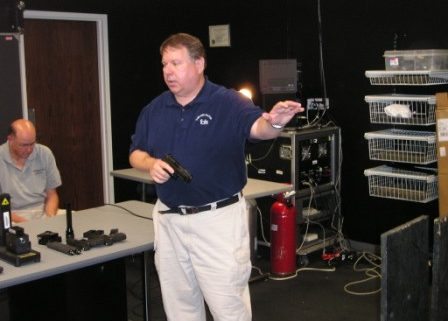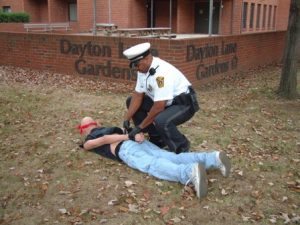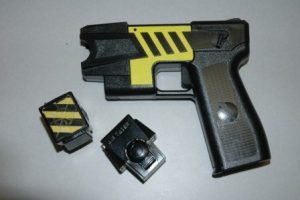Jerry Cooper: Use Of Force Tips For WPA Attendees
Use-of-Force Tips for the Writers Participating in Simulation Training at the Writers’ Police Academy
Part I. Use-of-Force Legal Issues
By Jerry P. Cooper, Use-of-Force Trainer / Consultant
Statutory law covering use of force varies from state to state; however, there are certain similarities. Generally, we divide use of force into two main categories: 1) less-lethal; and 2) lethal.
A less-lethal force option is one which is unlikely to cause death or serious injury to a suspect when properly applied by a law enforcement officer. A law enforcement officer is justified in using less-lethal force against a person to prevent the escape from custody or to effect an arrest of a person who he or she reasonably believes has committed a criminal offense, or to defend himself or herself (or a third party) from what the officer reasonably believes to be the use or imminent use of physical force.
A law enforcement officer is justified in using lethal physical force upon another person to defend himself or she or a third party from what he or she reasonably believes to be the use or imminent use of deadly physical force. We all know what deadly force is. Deadly force could be a gun; a gun used to strike someone rather than shoot them; a knife; an automobile; a brick; or anything else by its use could be used to cause death or a serious bodily injury. The problem comes when we must determine what constitutes the “imminent” use of force, whether deadly or not. “Imminent” is not a word we use here in the South; we have another term: “fixing to” (as in Joe is “fixing to” whip Bubba’s rear end). A situation is imminent when it is going to happen unless someone intervenes now, not five minutes from now, or even five seconds from now.
Deadly (lethal) force can be used to make an arrest or to prevent the escape from custody of a person who he or she reasonably believes is attempting to escape by means of a deadly weapon. Since the United States Supreme Court case of Tennessee v. Garner in 1985, we cannot use lethal force against a person who is simply committing a felony or escaping with a deadly weapon. Lethal force can also be used by a law enforcement officer against a person who by his/her conduct or any other means indicates that he/she presents an imminent threat of death or serious physical injury to others unless apprehended without delay.
When it comes to federal officers, lethal force is justified if the suspect represents a significant threat of death or serious injury to an officer or others. the threat of death or serious injury does not have to be imminent.
Use-of-Force by law enforcement officers is not only governed by statutory law, but also by constitutional law. We will consider just a very few seminal cases from the United States Supreme Court pertaining to this matter.
• Tennessee v. Garner (1985). The Court stated that if an officer has “probable cause to believe that the suspect poses a threat of serious physical harm, either to the officer or to others, it is not unconstitutionally unreasonable to prevent escape by using deadly force.”
– Graham v. Conner. In 1989, the Court stated “The reasonableness of a particular use of force must be judged from the perspective of a reasonable officer on the scene, rather than the 20/20 vision of hindsight …” The Conner decision established what has come to be known as the Objective Reasonableness Standard. Objective reasonableness will be determined by examining the number of factors which are involved in the officer’s decision to use force and the lawfulness of that decision will turn on the facts and circumstances known to the officer at the time the force was used.
– Saucier v. Katz (2001). This decision is known as the “Hazy Border Decision.” The Court plainly stated that while uses of force by police occur that are clearly excessive or clearly appropriate, a gray area remains in between. The Court went on to say that when an officer’s use of force falls within this gray area, deference must be paid to the officer and qualified immunity granted.
– Scott v. Henrich. In this 1994 decision, the court stated “Officers thus need not avail themselves of the least intrusive means of responding to an exigent situation; they need only act within that range of conduct we identify as reasonable.”
The Objective Reasonableness Standard set forth in the Graham v. Conner decision has been probably the most shaping U. S. Supreme Court decision concerning use-of-force. A reasonable officer acts in accordance with statutory law, constitutional law, departmental policy and training. The elements of reasonableness are: 1) ability; 2) intent; and 3) jeopardy. Ability addresses the capability of a subject to carry out an action or threat. Intent is indicated by a person’s words or actions. Jeopardy is present when the situation becomes imminent.
We no longer use the term “force continuum.” A continuum seems to imply that there is some distinct path we must follow in escalating or de-escalating levels of force. The proper term is “force options.” Usually, there is no one right option. A particular option only need be reasonable. Force options include lethal force, intermediate force, physical control, chemical agents (e.g., OC spray), and electronic impulse devices (e.g., TASER).
Intermediate weapons can be divided into high impact and low impact. Some restraining devices may be considered low impact intermediate weapons. Most intermediate weapons fall into the high impact category. These weapons involve strikes or actions which could cause temporary incapacitation. Such weapons include, but are not limited to, batons, K-9’s, bean-bag rounds, and pepper balls. Some courts have ruled that the mere use of a tactical team constitutes an intermediate level of force.
Physical control can be soft hand or hard hand. Here, “hand” simply means the use of any body part as a weapon, and not actually limited to the hand. Soft hand would include such things as escorts and pressure points. These are usually low levels of force that are used to motivate a person to cooperate. Punches, kicks or stuns would be examples of hard hand physical control. Depending on the application method, handcuffing could be either a low impact intermediate weapon or soft hand or hard hand physical control.
There are two other very important force options that are usually not considered in statistics concerning use of force, and neither is included in the International Association of Chiefs of Police’s (IACP) definition of force. They are command presence and verbal direction and control.
How could simply displaying a presence constitute a use of force? Presence, or command presence, is a psychological force. This type of force is usually demonstrated through symbols of authority (e.g., badge, uniform, police vehicle, etc.). You do not believe presence is a force? Observe how people behave when an officer in uniform approaches. People will start or stop certain activities. Individuals on certain “problem” street corners will act one way when ordinary vehicles drive by, and will act differently when a marked police car approaches. Even when an unmarked Ford Crown Vic or Dodge Charger draws near, people at such a location will behave differently.
Demonstrating a command presence means appearing ready and willing to do the job. This is accomplished by such things as an officer’s stance, use of positioning concepts, and maintaining a reactionary distance from the subject. George Thompson, creator and author of Verbal Judo, says that in order for an officer to demonstrate a command presence he/she must look good, sound good, and know good. Looking good and sounding good means displaying a professional appearance and voice. To know good means to know your job; know the procedural and substantive laws you are dealing with. Most professional law enforcement agencies now include a show of force (e.g., keeping a firearm drawn and at a low-ready position) as a type of command presence. Unfortunately, some agencies still consider such a show of force as actual use of force, and consequently, the involved officer must complete a use-of-force report and follow other administrative procedures. In those agencies, officers frequently wait too long to draw their weapons, so as to avoid the administrative headaches. The officer, fellow officer, or citizen the officer should be protecting, then faces a greater possibility of being injured or killed.
Proper verbal direction and control has diffused many potentially dangerous situations. Loud, repetitive verbal commands can simultaneously accomplish several things: 1) instruct the suspect as to what exactly you want him/her to do; 2) force you to breathe; 3) creates a witness; and 4) summons help.
Do not use profanity. A defense attorney in a criminal case, or the plaintiff’s attorney in a civil case, can offer the fact you used profanity as evidence that you were out of control. Members of tactical teams can sometimes get by with shouting and using profanity because most courts understand that their safety depends upon speed, surprise, and violence of action; but this is an exception to the rule, and does not apply to officers in other assignments.
Commands should be alpha commands. Alpha commands are directions given in concise, clear language (e.g., “stop”; “drop the knife”; “don’t take your hands out of your pockets”; etc.). We should never use beta commands (e.g., “give it up”; “freeze”; etc.). The most useful verbal command is simply “Police, don’t move.” In this short command we give an instruction, check for compliance, and satisfy the legal requirement that we identify ourselves as law enforcement officers.
Remember, the use of a particular force option, whether it is command presence, lethal force, or anything between, must only be reasonable. According to Scott v. Henrich, we are not required to use a minimum amount of force.
(Part II on Wednesday will address tactical considerations)
* * *
Writers’ Police Academy Updates and News
– We’ve added a second Firearms Training Simulator. Thanks to instructor Jerry Cooper you’ll have double FATS time, if desired. The option is yours.
– Psychologist/author Rick Helms has joined the academy staff and will be presenting a fabulous workshop titled Inductive and Deductive Profiling of Serial Offenders.
– Due to a sudden change in filming, Michael Cudlitz will not be able to join us for the academy. He expresses his regret and wishes you all well. Michael promises to join us for future events. We wish him well with his new project, The Grief Tourist, a film (the one that caused the schedule change) in which he’ll be starring and producing.
– Remember, personal weapons are not permitted at the police academy. This means ALL weapons! No firearms, ammunition, knives, Tasers, stun guns, pepperspray, etc. Any violation of this important rule WILL result in immediate dismissal. No exceptions and no refunds.
– Registration will take place at the academy, NOT the hotel.
– The Southeast Chapter of Mystery Writers Of America has joined as a co-sponsor of the Friday night reception. Karen McCullough, chapter president, will be stopping by to say hi. Thanks SEMWA!
AND…don’t forget, tonight’s the season opener of Castle. I am, however, not at home and am without a DVR, so I’ll probably miss a few things. Therefore, why don’t you guys make some notes (pick out the good and bad police procedure and forensics) and let’s discuss it tomorrow. See you then!









